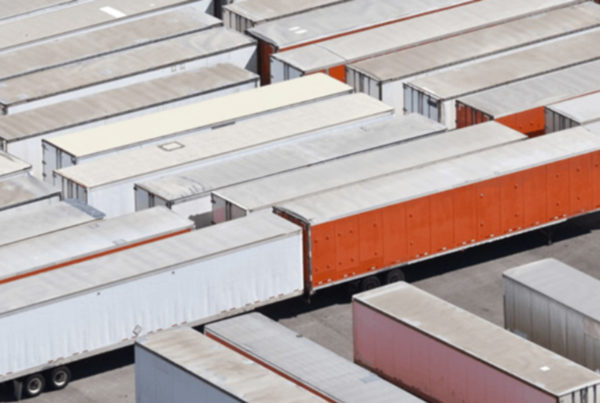Fleet managers need to do everything they can to protect life and cargo on the road. Discover how to improve your fleet’s safety and reduce accidents.
Accidents can happen in all walks of life, but in the world of transportation, deliveries and road haulage, they can represent a huge cost and danger, making them a vital consideration that fleet managers need to be aware of every working day. Road safety is at the heart of the role, because it’s important to ensure the safety not only of the cargo being transported, but also of the drivers and other road users.
Cutting down on accidents will keep stakeholders happy, while also protecting the reputation of your brand and reducing losses caused by repairs, maintenance and lost business.
Reduce accidents and increase safety
Fleet managers can help reduce the number of accidents involving their vehicles in a number of ways. This includes careful planning and training, as well as making modifications to improve the safety of trucks and trailers while on the road. Advanced driver-assistance systems (ADAS) are essential to facilitate several aspects of responsible truck driving and reduce the chance of human error.
Many other connected technologies can be fitted to further improve vehicle safety and reduce the likelihood of accidents. SafeStart, which automatically brakes a trailer when a lifted tipper or open filling dome is detected, and TailGUARD™, which uses rear blind spot detection sensors to automatically brake when impact is imminent, are vital in lowering the chance of costly collisions.
Cutting down on accidents will keep staff, stakeholders and customers alike happy, while also protecting the reputation of your brand and reducing losses caused by repairs, maintenance and lost business.
Driver performance and training
External factors can have a big role in accidents on the road, but there’s no doubt that driver error has a similarly huge role to play. Research by Volvo shows that of the approximate 26,000 road fatalities across the EU every year, around 15% are truck-related. In 2014 there were 3,863 fatalities involving trucks, of which 499 resulted in the death of the truck driver.[1]
Fleet managers can help reduce the number of accidents involving their vehicles in a number of ways.
You’ll be able to see how often they exceed speed limits or overuse the brakes. TX-ECO maps and evaluates driving behaviour to help you to identify those employees who would benefit from truck driver safety training – to improve the overall safety of your fleet. WABCO Academy can help through a variety of driver training programs based around reducing injuries, accidents and vehicle downtime.

While you can’t legislate for what the drivers of other vehicles do, you can do your best to ensure your drivers are the best they can be. Modern telematics devices provide you with a huge amount of data on driver performance, which can be used to see how economical and ecological their driving is, but also how safe.
Fatigue on the road
Driver fatigue can also affect commercial vehicle safety. A study found that approximately 40% of fatigue-related crashes involve the drivers of commercial vehicles, [2] an issue compounded when you consider the size of the trucks involved and the damage they can cause.
You can ensure that your drivers, whether medium or long-distance, are getting enough rest and not driving for longer than they’re legally allowed to by using tachograph data. Through this you can check that they’re taking enough rest breaks and aren’t endangering themselves, others and the cargo being transported. Modern telematics devices and connected software can give you an overview of all that data, which also makes it easier to provide that information to the relevant authorities. Moreover, telematics devices equipped with displays like TX-SKY, or paired with mobile apps such as TX-FLEX, can provide real time overview of driving & resting time information to the drivers, which helps avoid violation of tachograph regulations.

Maintenance
Maintenance can be a two-pronged headache. On one hand, accidents on the road can be dangerous for all concerned, while having vehicles off the road while they’re being repaired can be expensive and lead to problems with deliveries and customer service.
Happily, there are numerous diagnostic tools that can help you keep such issues to a minimum. These will let you deal with problems before they come to a head, so you can schedule preventive maintenance and order replacement parts in advance – such as monitoring tyre pressure across your fleet, preventing blowouts, accidents and downtime. They will also tell your drivers (and you) if a problem is developing, giving you both the chance to take action.
Remote truck diagnosis is also possible with TX-DIAGNOSTIX. This reads out fault codes, describing the cause and how it can be solved – providing quick fixes before maintenance issues develop into something serious. TX-TRAILERPULSE also helps fleet managers to remotely check the technical health of their trailers and schedule maintenance in advance, reducing downtime.
Real time support
One issue affecting many drivers and fleet managers is providing real-time support. This can be extremely useful as you can use telematics devices with a screen, such as TX-SKY and the mobile telematics app TX-FLEX, to relay any issues or information quickly.
This is one of the benefits of digitisation. From your base, you can allocate the best route for drivers’ journeys. This enables you to make decisions on the fly, rather than relying on a driver to adjust to circumstances without all of the information they need.
Driver feedback
Your relationship with drivers shouldn’t be just one of you telling them what to do and where to go. It is important that communication with them is two-way. They’re often the best people to make suggestions, provide feedback on routes and safety, and highlight possible improvements.
Don’t neglect driver communications, keep the lines open and take on board their feedback. This may be feedback when they are back at base but you can also use new tools and devices to keep in touch while they’re on the road. You can use software to collate feedback from drivers, give other concerned parties such as stakeholders and senior management a view of it, and use that to plan and strategize.

If a driver has an issue when they reach a customer and needs to get in contact with their fleet manager to resolve it, or to communicate a vehicle breakdown, this can often be outside the cabin. In such instances TX-FLEX offers a solution, as it runs on an Android device and facilitates activities away from the truck, such as barcode scanning, pallet handling, problem reporting and many others. It can highlight problems as they occur and make sure the right action is taken to avoid safety issues or accidents.
Ensuring road safety across your fleet is all about a combination of truck and trailer telematics, communication, driver training, support and putting the tools in place to help you see the bigger picture.



